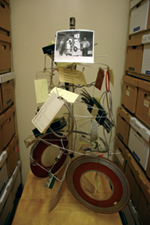Memory tree
 Photo: SLAC |
The SLAC archives, in the windowless basement of the Central Laboratory Annex, are no greenhouse. Yet for the past few years, a small tree has adorned the den of SLAC's archivist Jean Deken. “It hasn't grown any compared to trees outside, but it hasn't lost any of its fruit,” Deken says with a knowing smile, while gently dusting off her three-foot- tall ward.
Nor is it likely to wither soon from lack of rain or want of sunlight: its trunk is made of steel, its branches of aluminum wire, and its leaves of old computer parts.
Members of the SLAC computing services assembled this whimsical curio 22 years ago to honor—and chide—their colleague John Ehrman, who was leaving them after 15 years for a job at IBM. A programmer and author of many manuals for SLAC computer users, Ehrman was known for a relentless sense of humor—which proved contagious. So, while some longtime SLAC employees are remembered by a solemn redwood, a cheerful crabapple, or a delicate hawthorn, Ehrman's legacy lives on as a metallic tree bearing dog-eared punch cards, scratched magnetic disks, a lonesome circuit board, a couple of tape-drive rings, a dial-up 300-baud modem, and other memorabilia of the bygone era of mainframe computing.
Time will tell which will have the last laugh, of the timeless but perishable redwoods or the outdated but durable little computer tree.
Françoise Chanut






